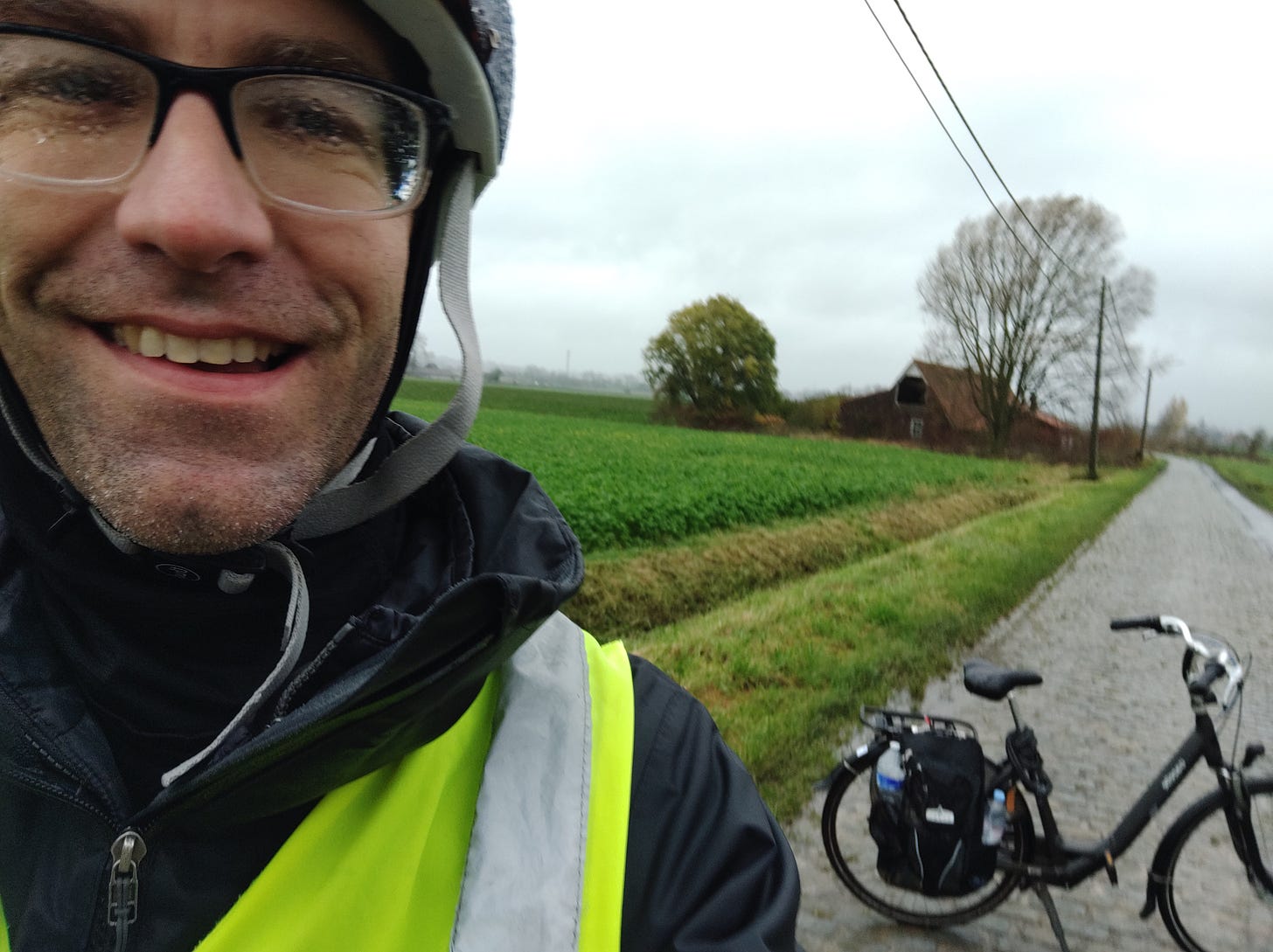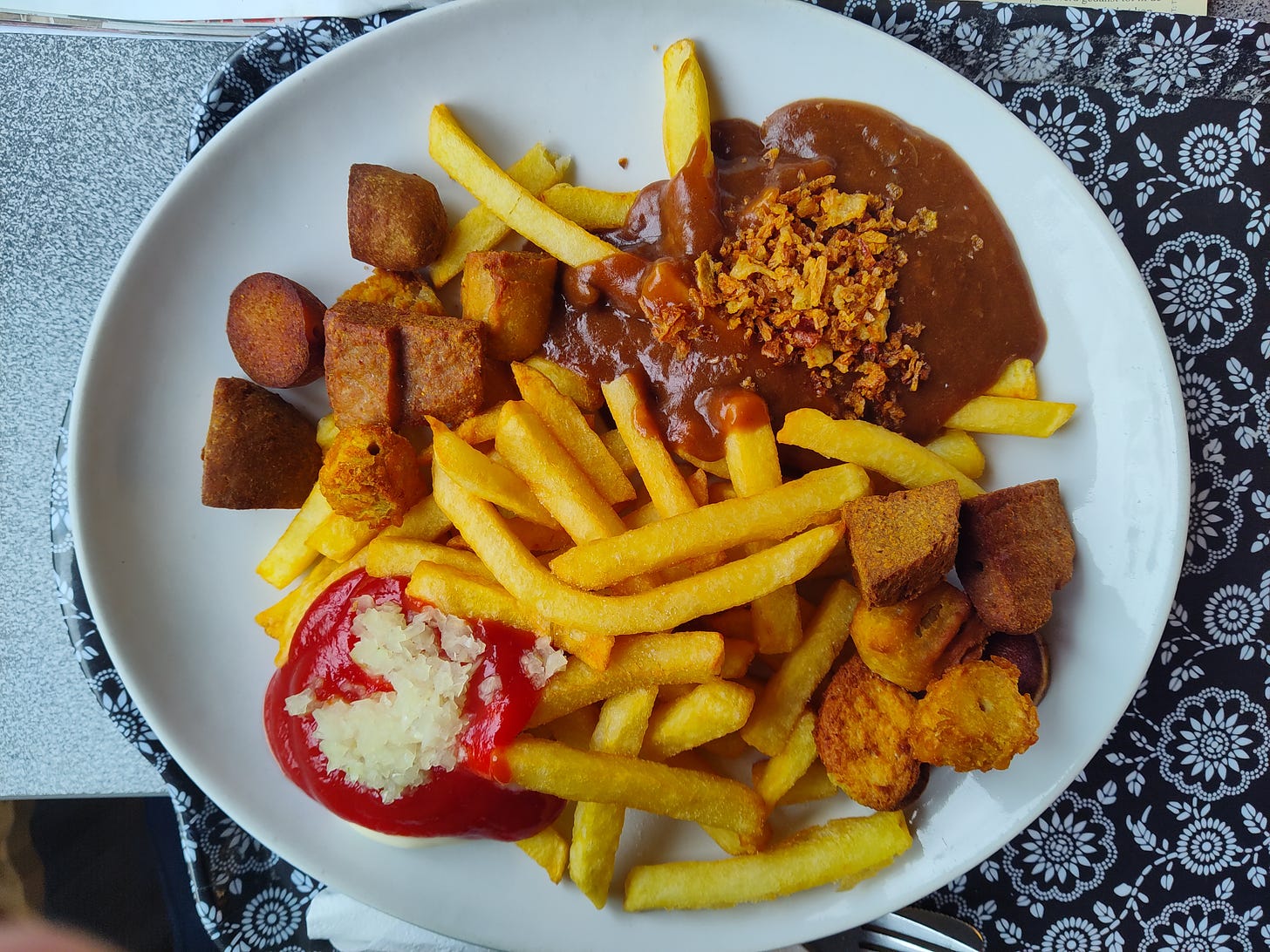I realize writing this up now that the best day of my recent bike tour was one where nothing much worked out, and it barely stopped raining the whole day. If you find the Low Countries enchanting then you probably appreciate a soggy day. At my Tournai accommodations, I also noticed I was not terribly worried about having my bike stolen. While I slept someone gently repositioned the bike (which was locked only to itself). Is it a trap to trust in the benevolence of unseen strangers? I didn’t get burned, this time anyway.
The rain started just as I got to Tournai’s lovely medieval town square, and the five-towered, 12th century church which some call the finest in Belgium. Neither the church nor the belfry were accessible though, so I just tried to soak up the ambience of the quiet old city and hoovered up a pain au chocolat.
Tournai has an almost Nordic tidiness compared to the Lille area. The rain seemed to slide off the engineered smoothness of the cobbles. I’m told that the Netherlands disdains Belgium for its slovenliness, and Belgium looks down on France for the same reason. My northward trajectory brought me into more and more fastidious landscapes.
No church and no belfry, but I saw a plaque that proudly proclaimed that Tournai was the first liberated city in the country in 1944. A happy thought, to imagine the scene as the Allies initiated “postwar Belgium.” Without gaining entry to anything else in town, and not being much interested in souvenir shopping, I descended to the river and checked out the bridges whose stone constructions reference a thousand years of Tournai, while mostly dating to the 1940s.
And I beheld the River Scheldt: a three-nation legend from out of the history books that I was finally seeing for myself. Gerardus Mercator grew up on its banks when its wild floods could create a boundary as significant as that between France and England, according to biographer Nicholas Crane. The undammed Scheldt, along with the Meuse and the Rhine, divided industrious Brabant from Gelderland, the dominion of the belligerent Duke Karel.
Crane has a great way of dramatizing geography. What I found though was an utterly domesticated waterway, less than a stone’s throw across, along a well-maintained bikepath with only a little storm-debris decorating it. I sailed through a placid group of ducks.
In the humble town of Pottes I stopped at a little shop for bottled water (Spa), a couple of brews (Westmalle) and bars of chocolate (Côte d’Or). I was a little abashed to even walk the narrow aisles, so soaked was I from the weather. But both shopkeeper and a fellow customer gave me glad tidings (“Bon courage!” and “Bonne balade!” in reference to my bike). The faintest bit of encouragement can keep me pedaling through the rain.
No outdoor people interrupted my observation of the secure, intensely respectable suburban houses. They often had just one or two signs of eccentricity, like a unicorn placard on the garage. Many more solar panels than I remember from my stint in the country twenty years beforehand. The houses on the outskirts of towns often sat on small green farms, and from the vantage point of the street you could see how high the topsoil was stacked. Dirt is its own kind of wealth, especially if it almost never dries out. Napoleon called Benelux “the deposits of French rivers,” a perfectly arrogant although somewhat accurate description.
Far above the Scheldt rose the mountaintops of the “Flemish Ardennes,” a designation that I had thought was just marketing for tourism. The Ardennes forest has rolling hills and vales while northern and eastern Belgium is almost completely flat. But now I could see why this area hosts cycling’s Ronde van Vlanderen (“Tour of Flanders”). Mont de l’Enclus, Hotondberg and Kluisberg all exceed 140 meters of altitude, climbs that my heavy Gazelle bike, toting glass bottles of beer, could not handle. The wooded mountains, veiled thinly by the rains, matched my idea of what Rhineland looks like.
I couldn’t postpone lunch any longer and I knew I needed some of Belgium’s national junk food. In my hungry state I hadn’t realized that the town of Ronse was on the Flemish side of the language border. Although it is one of four Flemish communities outside the Brussels area that officially have “facilities for French-speakers,” the guy at the counter was a little off-balance when I ordered “frites royales.” Maybe I was too proud to speak English, but in retrospect I probably could have muddled through a Dutch lunch order, except that he probably would have switched to English upon noticing my halting pronunciation and hand gestures. In any case, lunch hit the spot.
Ronse is another town famous for a medieval church. I really wanted to see the crypt of Sinthermeskerk, which features the relics of an exorcist who lived in the 2nd century CE. There are still the iron rings to which the demented were shackled as they awaited exorcism. These poor souls were made to soak in baths in this haunted basement before clerics did whatever it was to make their spectral tormentors vanish. But no one was there to let me in, so I kept on.
I had to crest a wide ridge before descending into my destination for the night, the cycling capital of Belgium, Oudenaarde. Approaching from the south, with the whole town laid out beneath me, made me feel almost like Patrick Leigh Fermor. Oudenaarde was celebrating Christmas already, and before I checked into the bike-themed Hotel Leopold, I could hear children singing their odes to Sinterklaas.






